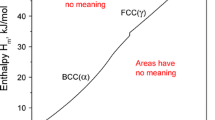Abstract
Melting is a most familiar phenomenon: closely similar patterns of solid/liquid transformation occur on heating innumerable and diverse crystalline substances. While some behaviual trends have been characterized, no melting theory of general applicability has yet found widespread acceptance. The present comparative survey is concerned with the melting of metallic elements, to determine quantitatively the enthalpy and density changes that accompany these solid/liquid transitions. The relationship of melting with other physicochemical processes is considered. Metals were selected as apparently the simplest systems for this analysis, many crystal structures involve the close packing of (at least approximately) spherical atoms. Appropriate physical data are available for a large number of different elements, some 70 are considered here, representing a wide range of melting points, T m. Aspects of the kinetics and mechanisms of melting are discussed. These data comparisons show that melting enthalpies for metals are relatively small. The averages found represent only about 26% of the energy required to heat these solids from 0 K to completion of melting at Tm and only about 5% of the volatilization enthalpy. The density changes on fusion are also relatively small, on average -4.7%. To account for these observations, a representational model of fusion has been formulated. It is suggested that, on melting, the bonding and of local structural dispositions between neighbouring atoms in the liquid and in the solid condensed phases undergo changes that are only limited in extent. Thus, the regular ordered structures, characteristic of crystalline phases, are extensively maintained in the melt at Tm. Melting is ascribed to destabilization of the crystal through excess vibrational energy, resulting in replacement of the overall extended and constant rigid structure of the solid by a dynamic equilibrium between small, locally regular domains in the liquid. Each such structurally ordered domain is a region of one or other of the alternative possible, crystal-type structures of comparable stability. In the liquid, constant transfer of the components between these regular arrays, stabilised by the enthalpy of fusion, within the compact assemblage of domains accounts for the fluidity of the liquid, its inability to withstand a shearing force and the absence of long-range order. Melting is, therefore, identified with relaxation, at T m, of the constraint that only a single lattice form is present (as in a crystal) and the liquid is composed of all the structures that are sufficiently stable to participate in the constant flux of interconverting domains. This model of melting may have wider applicability. The small modifications both of enthalpy and of density on fusion make the formulation of a quantitative model, capable of predicting T m, difficult because minor or secondary controls may be significant in determining the temperature of this physical phase change and the structural changes that occur.
Similar content being viewed by others
References
A. R. Ubbelohde, The Molten State of Matter, John Wiley, Chichester 1978.
D. R. Lide (Ed.), Handbook of Chemistry and Physics, 78th Ed., CRC Press, New York 1997-1998.
J. A. Dean (Ed.), Lange’s Handbook of Chemistry, 15th Ed., McGraw-Hill, New York 1999.
Y. S. Touloukian and E. H. Buyco, Thermophysical Properties of Matter, Vol. 4, Specific Heat, IFI/Plenum, New York 1970.
M. A. Omar, Elementary Solid State Physics, Addison-Wesley, Reading, Massachusetts 1975, p. 80–86.
Ref. [3], Table 6.4.
Ref. [2], 12, 191–2.
Ref. [2], 12, 19–21.
A. F. Wells, Structural Inorganic Chemistry, 4th Ed., Clarendon, Oxford 1975, p. 1014ff.
Ref. [2], 5, 5–25.
Ref. [2], 4, 126–9.
Ref. [2], 10, 214–5.
Ref. [2], 10, 187–8.
Ref. [2], 10, 201–2.
Ref. [2], 12, 18.
Ref. [2], 12, 43–44.
Ref. [2], 12, 124.
Ref. [1], Ch. 3.
Ref. [2], 9, 51–56.
Ref. [2], 12, 34.
P. Franzosini and M. Sanesi, Molten Salt Techniques, Vol. 1, (Ed. D. G. Lovering, R. J. Gale), Plenum Publishing, New York 1983, Ch. 8.
S. J. Peppiatt and J. R. Sambles, Proc. R. Soc. London, A345 (1975) 387, 401.
A. K. Galwey and M. E. Brown, Thermal Decomposition of Ionic Solids, Elsevier, Amsterdam 1999.
A. K. Galwey, D. B. Sheen and J. N. Sherwood, Thermochim. Acta, 375 (2001) 161.
A. K. Galwey and G. M. Laverty, Solid State Ionics, 38 (1990) 155.
P. D. Garn, J. Thermal Anal., 13 (1978) 581.
U. Muller, Inorganic Structural Chemistry, John Wiley and Sons, Chichester, 2nd Ed., 1992, Chs. 5, 9.
Ref. [2], 8, 20–25.
K. J. Laidler, J. Chem. Ed., 61 (1984) 494.
A. K. Galwey, to be published.
Ref. [9], p. 119–120.
A. R. West, Solid State Chemistry and its Applications, John Wiley and Sons, Chichester 1984, p. 51.
D. Kuhlmann-Wilsdorf, Phys. Rev., 140 (1965) A1599.
K. Ksiazek and T. Gorecki, High Temp. Mater. Proc., 3 (1999) 297.
K. Ksiazek and T. Gorecki, J. Mater. Sci. Lett., 20 (2001) 901, 1623.
Author information
Authors and Affiliations
Rights and permissions
About this article
Cite this article
Galwey, A.K. Aspects of the melting of metallic elements. J Therm Anal Calorim 79, 219–233 (2005). https://doi.org/10.1007/s10973-004-0587-0
Issue Date:
DOI: https://doi.org/10.1007/s10973-004-0587-0




